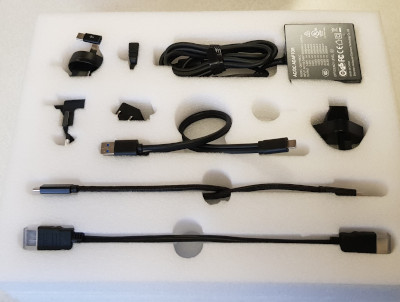NexDock 2 – Laptop style screen and keyboard for Raspberry Pi or mobile phones
A few years ago I backed a Kickstarter project for the original NexDock for use with the Raspberry Pi. Last year they created an updated version called the NexDock 2. A new improved version.

You can see my NexDock 2 unboxing and review video here, or read on for more information.
What is a NexDock?
A NexDock looks like a laptop, but it’s missing one thing, a processor. It has a screen, keyboard (with touchpad) and battery in a laptop style shell. It cannot work as a laptop until you connect it to a computer.
So what’s it used for? Well most people now carry a fairly powerful computer in our pocket, it’s a mobile phone and the two things that stop it being used as a computer are a decent sized screen and a keyboard. Put the two together and you have what is effectively a full computer. That is one way that I’ve used the NexDock but for more I found it particularly useful when used in combination with a Raspberry Pi. It provides a quick and easy way to connect to a Raspberry Pi which may be embedded in a Robot, inside a model house, or even in a wearable snowman badge.
NexDock 2 with a mobile phone – Samsung S8 Dex
Firstly I tried by connecting it to a mobile phone. It works with a number of Android phones with a USB-C connector, in my case a Samsung G8. The Samsung phone includes Dex which provides a full laptop like environment which works well with the phone. Many apps can expand to use the full screen, although not all Android apps support that. The main thing for me is that it allows you to send emails or write documents using a keyboard instead of the on-screen keyboard.

NexDock 2 with a Raspberry Pi
The NexDock 2 appears to work with all versions of the Raspberry Pi. This is an improvement over the earlier NexDock which struggled with the Raspberry Pi Zero. Also the NexDock 2 no longer uses Bluetooth so you don’t need to find a temporary keyboard whenever the bluetooth fails to connect. This does mean that you have to connect a physical cable for the keyboard to work, but then you have to use a HDMI cable anyway. This is a big improvement on the older NexDock.

Supplied cables and accessories
There is a good selection of supplied cables and adapters as shown in the photo below:

The NexDock 2 is powered from a USB-C charger which is included along with different adapters for different country sockets (a big improvement on the travel adapter supplied with the previous version). It also includes all the cables that you will need to connect to a USB-C smartphone, Raspberry Pi (1 to 3) and Raspberry Pi 4. If using a Raspberry Pi Zero then you will need to source your own mini-HDMI to HDMI adapter (or cable) and a micro-USB OTG adapter, however most people with a Pi Zero will likely have these already. The cables are all fairly short, which should work with it’s designed use, but it’s easy enough to provide your own longer cables if you need anything extra.
Any issues?
So far I haven’t come across any major issues. It appears to work with my mobile phone and different versions of the Raspberry Pi.
If there was one thing I would change it would be to include a UK keyboard layout. I accept this is difficult to do on a Kickstarter project, but it would be a big improvement. The reason being that when using a Raspberry Pi then you may need to make use of some of the special characters that need different key combinations. Changing the keyboard layout each time you connect a NexDock versus a UK keyboard is a bit of a pain. For me the main thing is some of the keys used on the Linux command line which I had to find through trial and error.
Other than that any other things are very minor.
Summary
I don’t use the mobile phone Dex very often, but that is a useful thing to have. For me the main reason for the NexDock 2 is to connect to a Raspberry Pi either during initial setup or when it’s connected as part of a project. For that the NexDock 2 is great. It provides a reliable keyboard and screen which is much easier than lugging a standard monitor around. It also includes a built-in battery which can even power the Raspberry Pi.
If you regularly need to connect to a Raspberry Pi when you don’t have a screen to hand then I highly recommend getting a NexDock 2.
Missed the Kickstarter? You can pre-order using the link below.
